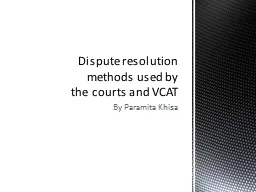

Dispute resolution methods used by the courts and VCAT VCAT and court use a range of methods to resolve criminal and civil disputes Criminal cases are solved by the judge in courts Most civil cases proceed through one ore more methods of alternative dispute resolution ADR in am attempt for ID: 591689
Download Presentation The PPT/PDF document "By Paramita Khisa" is the property of its rightful owner. Permission is granted to download and print the materials on this web site for personal, non-commercial use only, and to display it on your personal computer provided you do not modify the materials and that you retain all copyright notices contained in the materials. By downloading content from our website, you accept the terms of this agreement.
Slide1
By Paramita Khisa
Dispute resolution methods used by the courts and VCAT Slide2
VCAT and court use a range of methods to resolve criminal and civil disputes.
Criminal cases are solved by the judge in courts.
Most civil cases proceed through one ore more methods of alternative dispute resolution (ADR) in am attempt for parties to resolve their dispute themselves.Alternative Dispute Resolution (ADR) included processes other than judicial determination, in which an impartial third party assist in resolving the dispute between the parties.ADR include mediation, conciliation and arbitration ADR is now compulsory step in most state courts before civil matters reach a hearing before court or VCAT
DISPUTE RESOLUTION METHOODS Slide3
In mediation parties try to resolve their disputes themselves with the help of an independent and impartial third parties whose role is to keep communication flowing between the parties. The third party in mediation is called the mediator.
Mediator do not offer advice or interfere, but they facilitate the discussion and help each party to understand the others point of view.
The end result of mediation is not legally binding so parties may not choose to follow throughMediation allows parties to have their say with out being restricted with strict rules and procedure.It promotes an win-win solution where both parties are satisfied with the out come.
MEDIATION Slide4
Strengths
Weaknesses
More cost efficient than courts
Parties have control over the discussion
Promotes a win-win out come
Promotes an on going relationship between the parties Frees up the court system Will only work if both parties are willing to negotiate The outcome is not legally binding, (only if deed of settlement is signed); so it can be a waste of money and time. More confident party can overtake the discussion
EVALUATION OF MEDIATIONSlide5
Parties attempt to resolve their dispute themselves with the help of an impartial and independent third party; the conciliator who tries to help the parties reach an agreement by listening to the evidence and arguments of each party and making suggestion on how to resolve the dispute
The difference between conciliation and mediation is that the third party exercises a greater responsibility over the outcome.
The outcome of conciliation is not legally binding but the parties are more likely to follow through because is was made with an help of a third party. CONCILIATION Slide6
Strengths
Weaknesses
Less strict rules of evidence and procedure
Less time consuming and costly
Party satisfaction
Non- confrontational, which promotes an ongoing relationship Not legally bindingVoluntary; if they do not attend, the matter will have to be pursued through courts Legal representation is essential which may cause some parties to feel unrepresented EVALUATION OF CONCILIATION Slide7
An independent and impartial third party; the arbitrator listens to the evidence and arguments of the parties and makes the decision on their behalf.
The parties may have voluntarily agreed to follow the decision of the arbitrator or may be directed to arbitration.
Arbitration is more formal than mediation and conciliation but now as formal as court hearing.The final outcome in arbitration is legally binding ARBITRATION Slide8
EVALUATION OF ARBITRATION
Strengths
Weaknesses
The outcome is legally binding
Less formal than court More cos efficient than court Less time consuming Legal representative is not necessary.Less strict rules of evidence and procedure
Parties may be
dissatisfied with outcome.
Difficult to appeal
Doesn’t promote on going relationship
Parties may not feel represented since legal representative is not necessary. Slide9
Judicial determination involves resolving dispute by representing their argument and evidence to a judicial officer; such as a judge, magistrate or a VCAT officer) who makes an binding decision about the outcome.
Judicial determination is not a form of ADR.
The cases are to follow by the strict rules of evidence and procedure. Burden and standard of proof is required .Legal representative is requires due to the complex nature of court proceeding. They are to present their clients case in the best possible manner. JUDICIAL DETERMINATION Slide10
Strength
s
Weaknesses
The decision is binding
Judicial officers are experienced
legal professionals.
Parties may feel more satisfied with the outcome as a judge has decided the case for themIt is appropriate for civil and criminal disputes It is usually expensive because there is a need to engage with legal representatives The formality of the court system can be intimidating and confusing .If parties are dissatisfied with the outcome they have to undertake and appeal which is time consuming and costly
Can be inappropriate where relationship between the parties need to be maintained
EVALUATION OF JUDICIAL DETERMINATION